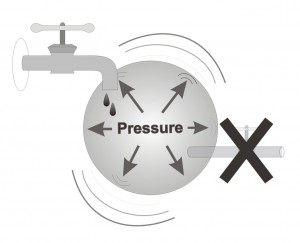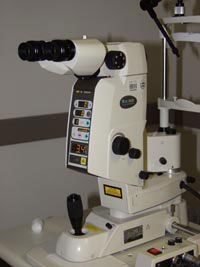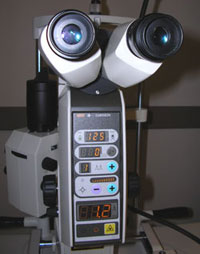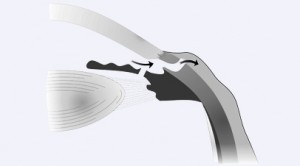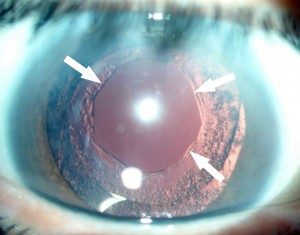Patients with the typical form of glaucoma (which is called open-angle glaucoma) are generally treated with eye-drops. When intraocular pressures remain high despite medical treatment, two additional treatment modalities exist: laser treatment or surgery, which are both powerful options to further reduce intraocular pressure. Laser treatment for open-angle glaucoma is called trabeculoplasty and its purpose is to improve the drainage of the aqueous humor out of the eye, which in most cases will lead to an additional decline in pressure.
This laser treatment has both advantages and disadvantages. The advantages include the fact that the treatment is very safe and only rarely do complications occur. The disadvantages of this treatment include the fact that it does not have an effect on all patients (on average it will have an effect on three out of four patients). Additionally, the duration of the effect is usually limited to a number of years (generally around five years). Such laser treatment helps to reduce intraocular pressure. However, it is not a substitute to eye drops, but rather, it is considered an additional treatment.
I will briefly describe the typical patient who is a candidate for laser treatment:
The patient is one with open-angle glaucoma treated with three types of drops. Despite the treatment, intraocular pressures remain between 20-25. There is an intermediate amount of damage to the visual field, and there is the impression of a slow worsening of the latest visual field as compared with the visual field performed the previous year. The ophthalmologist at the health fund (‘kupat cholim’) who examined the patient got the impression that the medical treatment (using drops) was not sufficient and considered the option of adding laser treatment or surgery. The patient came to my clinic for a second opinion and for treatment.
The patient underwent a detailed eye examination which also included pupil dilation, analysis of the visual fields (that he brought with him), and additional tests. Consequently, I was under the impression that it is indeed necessary to lower the pressure further in order to better stabilize the glaucoma. Firstly, I recommended laser treatment and informed him that if the laser treatment would be insufficient, it is possible that in the near future he would require surgery. The patient considered the information that he was provided with. After a short discussion with his wife he decided to go ahead with laser treatment. Two weeks later the patient underwent the laser treatment.
On the day of the treatment the patient arrived at the clinic, without requiring any special preparations, as if he were coming in for a regular check-up. The only difference was, that following the laser treatment the patient waited another half hour for a quick eye examination before returning home. No pain is expected during (or after) this laser treatment. The length of the actual treatment is about ten minutes. On the evening after the laser treatment it is advisable to spend a quiet evening at home, with no special events such as a play or dinner at a restaurant. One can read and watch television as usual immediately following this laser treatment. The next morning one can return to his/her regular routine without any restrictions.
From here we see that this type of laser treatment, called trabeculoplasty, is gentle in nature, is associated with almost no complications, and overall is considered an effective treatment for those cases in which it is deemed appropriate.
In order to prevent confusion and misinformation, it is important to emphasize that there are many different types of laser treatments for diseases of the eye. In the field of glaucoma, for instance, there are more than five different kinds of laser treatments, used in different situations, and each one is associated with a different risk/benefit profile.

